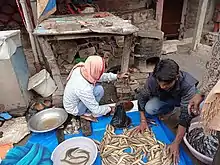Kewat
The Kewat are a Hindu caste, found in the states of Rajasthan, Madhya Pradesh, Chhattisgarh, Odisha, Bihar and Uttar Pradesh in India. They are the traditional boatmen of northern India.[1][2]
 Mallah a sub caste of Kewat, a boatmen-fishermen community. | |
| Regions with significant populations | |
|---|---|
| India | |
| Languages | |
| • Hindi | |
| Religion | |
| • Hinduism 100% • | |
| Related ethnic groups | |
| • Mallah |
Divisions
Their main sub-groups are the Banaphar, Dhivar, Balavarna, Chay, Sorahiya, Kairata, and Tiar. The Banaphar consider themselves to be superior to the other groups.[3]
Present circumstances
In Uttar Pradesh
The Kewat of Uttar Pradesh mostly live near the river Ganges. They are the traditional businessman.[4] They are among 17 OBC communities that have been proposed for Scheduled Caste status by the Samajwadi Party-controlled Government of Uttar Pradesh. However, this proposal, which relates to votebank politics and has been made in the past, has been stayed by the courts; a prior attempt was also rejected by the Government of India.[5][6]
In Rajasthan
The Kewat in Rajasthan are found in along the banks of the rivers Chambal, Benas and Kalinath rivers, in the districts of Kota and Sawai Madhopur. They are divided into eighty four clans, and their origin myth refers to them being created by god Vishnu. The community speak the Hadoti dialect of Rajasthani. There traditional occupation of being boatmen has declined,.[7]
In Bihar
In Bihar, they are both cultivators and businessman. The community are also known as Kewat Kaut. There is considerable difference of opinion as to the origin of the word Kewat. They are found in almost all the districts of Bihar but mostly in Madhubani , Jhanjharpur, Nirmalli, Bhagalpur, Purnea, Katihar, Darbhanga, Munger, Muzaffarpur and Khagaria, Saharsa, Supaul, Madhepura . Their villages are found mainly along the near of the Ganges river, and many have taken to cultivation. They speak Maithili, Magadhi and Bhojpuri.
A major population of kewat/keot/kaut live in the district of Madhubani. The farmers of the Jhanjharpur region are more prosperous while those belonging to the kosi (the flood effected) belt not so prosperous with many of them taken to jobs outside the state. Maithili is the major language spoken in the district of Madhubani, Darbhanga, Jhajharpur etc.[8]
References
- People of India Uttar Pradesh Volume XLII Part Two edited by A Hasan & J C Das pages 776 to 783
- People of India Rajasthan Volume XXXVIII Part Two edited by B.K Lavania, D. K Samanta, S K Mandal & N.N Vyas pages 515 to 519 Popular Prakashan
- People of India Uttar Pradesh Volume XLII edited by A Hasan & J C Das page 777
- People of India Uttar Pradesh Volume XLII edited by A Hasan & J C Das page 778
- "Setback for Akhilesh government as High Court stays their order to include 17 sub-castes in the SC category". Financial Express. 24 January 2017. Retrieved 4 February 2017.
- "UP govt to include 17 other backward castes in SC list". Hindustan Times. PTI. 22 December 2016. Retrieved 4 February 2017.
- People of India Rajasthan Volume XXXVIII Part Two edited by B.K Lavania, D. K Samanta, S K Mandal & N.N Vyas pages 515 to 519 Popular Prakashan
- People of India Bihar Volume XVI Part One edited by S Gopal & Hetukar Jha pages 507 to 511 Seagull Books